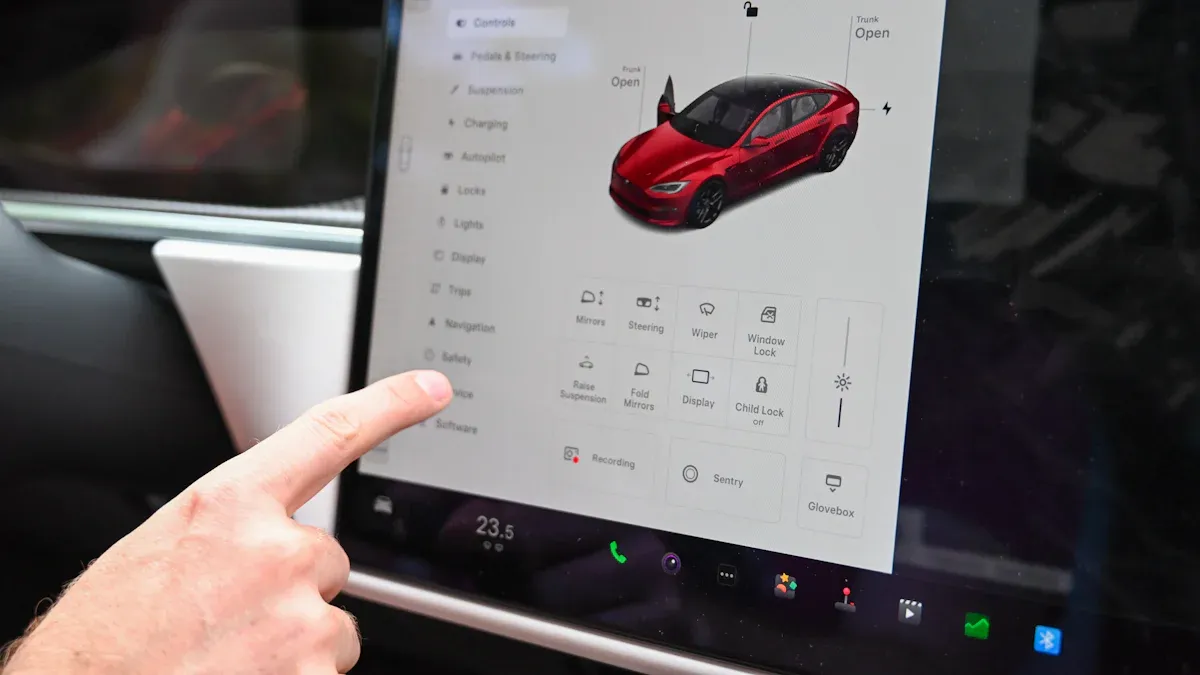How Haptic Steering Wheel Systems Are Revolutionizing Driver Safety and Experience

Road traffic injuries remain a leading cause of death for young people aged 5-29 years, according to the World Health Organization. This alarming reality underscores the importance of innovations like haptic steering wheel systems. By delivering precise haptic feedback, these systems enhance driver awareness and control, reducing risks and improving safety. With advanced components like INEED's Linear Vibration Motors, they provide tactile alerts that help you stay focused and respond quickly to road conditions.
Key Takeaways
Haptic steering wheels vibrate to help drivers stay alert and safe.
They give instant feedback, helping drivers avoid dangers and stay in control.
Car makers are using this technology to improve safety and driving experience.
The Technology Behind Haptic Steering Wheel Systems
What is Haptic Feedback
Haptic feedback refers to the use of vibrations, forces, or motions to simulate the sense of touch. This technology allows you to interact with digital objects as if they were physical. For example, when you feel a vibration in your phone after pressing a button, that’s haptic feedback in action. It relies on three sensory systems: cutaneous (skin), kinaesthetic (movement), and haptic (active touch). Together, these systems create a realistic sense of touch. Haptic feedback technology plays a vital role in virtual environments, gaming, and even advanced driver assistance systems. It enhances user interaction by providing tactile cues, making tasks like navigation or lane-keeping more intuitive.
How Haptic Steering Wheels Work
Haptic steering wheel systems use vibrating motors to deliver tactile alerts directly to your hands. These vibrations inform you about critical driving conditions, such as lane departure or upcoming turns. For instance, a vibrating steering wheel can guide you to stay in your lane without requiring visual or auditory distractions. Research shows that younger drivers are less distracted when receiving haptic feedback, improving focus and safety. These systems also collaborate with advanced driver assistance systems to provide real-time feedback, ensuring you stay aware of your vehicle’s trajectory and surroundings.
The Role of Linear Vibration Motors in Haptic Systems
Linear vibration motors, like INEED’s Linear Resonant Actuators (LRAs), are the backbone of haptic steering wheel systems. These motors generate precise vibrations using a voice coil and spring mechanism. Unlike traditional motors, LRAs offer faster response times and customizable settings, making them ideal for automotive applications. They operate efficiently at low voltages, ensuring energy savings. Their durability and precision enhance the reliability of haptic feedback, allowing you to experience consistent and accurate tactile alerts. Automakers like Tesla and Mercedes Benz have already adopted this technology, showcasing its growing importance in modern vehicles.
🚗 Did you know? The market for haptic steering wheel systems is projected to grow from $4 billion in 2024 to $11.73 billion by 2034, with a CAGR of 11.35%. This highlights the increasing demand for safer and more interactive driving experiences.
Enhancing Driving Safety with Haptic Steering Wheel Systems

Reducing Distractions Through Tactile Alerts
Haptic steering wheel systems play a crucial role in reducing distractions while driving. By delivering tactile alerts directly to your hands, these systems minimize the need to rely on visual or auditory cues. This approach lowers cognitive load, helping you stay focused on the road.
Research highlights that tactile alerts are highly effective in reducing distractions.
A study by Birrell et al. (2013) found that vibrotactile feedback improved throttle usage and reduced the mental workload of drivers.
These findings demonstrate how haptic feedback can enhance driving safety by keeping your attention on potential road hazards without overwhelming your senses.
Improving Navigation and Lane-Keeping Assistance
Haptic steering wheel systems also improve navigation and lane-keeping assistance. They provide subtle vibrations to guide you during turns or when you drift out of your lane. This ensures you maintain proper positioning without relying solely on visual indicators.
Key Findings | Description |
|---|---|
Haptic Feedback | Enhances driver performance and safety in semi-autonomous vehicles. |
Driver Control | Allows drivers to regain full control while receiving feedback from the system. |
Optimal Steering Feel | Creates a pleasant assisted steering feel, improving acceptance of the technology. |
Haptic communication strengthens the bond between you and your vehicle, ensuring a safer and more intuitive driving experience.
Real-Time Feedback for Safer Driving
Real-time haptic feedback enhances driving safety by providing immediate alerts about road hazards or changes in driving conditions. For example, a vibrating steering wheel can warn you of lane departures or upcoming obstacles. This instant feedback allows you to react quickly, reducing the risk of accidents.
A preliminary study revealed that haptic feedback could reduce energy consumption by 14%, promoting efficient throttle usage. This not only improves driving performance but also contributes to safer driving by encouraging smoother vehicle operation.
By integrating advanced driver assistance systems with haptic steering wheel systems, automakers are setting new standards for safety and efficiency on the road.
Real-World Applications and Future Potential
Automakers Adopting Haptic Steering Wheel Systems
Automakers worldwide are embracing haptic steering wheel systems to enhance driving safety and user experience. Tesla's Model 3, for instance, features capacitive haptic buttons that replace traditional physical controls. This design not only improves cockpit functionality but also reduces manufacturing costs. Similarly, Mercedes Benz integrates haptic feedback into its steering wheels, while Nissan's Ariya model uses this technology to provide tactile alerts for lane-keeping and navigation.
Here’s a closer look at how leading companies are innovating in this space:
Automaker | Innovation Description |
|---|---|
Toyota Motor Corp. | Advanced steering wheel design with biometric sensors to monitor driver health and alertness. |
Honda Motor Co., Ltd. | Steering wheel providing haptic feedback for lane departure and collision alerts. |
Hyundai Motor Co., Ltd. | Steering wheel with touch-sensitive controls and heads-up display to minimize driver distraction. |
TOKAI RIKA CO., LTD. | Steering wheel with gesture recognition for controlling in-car systems without looking away from the road. |
Ford Global Technologies LLC | Steering wheel with adaptive grip technology that adjusts resistance based on driving conditions. |
These innovations highlight the growing adoption of haptic systems in modern vehicles, setting new standards for safety and convenience.
Research and Studies on Driving Safety Improvements
Studies have shown that haptic steering wheel systems significantly improve driving safety. For example, research titled "Haptic steering support for driving near the vehicle’s handling limits" demonstrated how these systems help drivers maintain better control during challenging conditions. The study also found that haptic feedback reduces both mental and physical strain, making driving less stressful.
Another study, "Vibrating Steering Wheel: Keeping Drivers Focused on the Road", explored the impact of haptic feedback on driver focus. It revealed that younger drivers benefited the most, as the vibrating steering wheel improved their attention to the road. However, the study suggested that older drivers might require tailored designs for optimal effectiveness.
Study Title | Description | Findings |
|---|---|---|
Haptic steering support for driving near the vehicle’s handling limits | This study developed and evaluated a haptic steering support system to enhance driver control near vehicle handling limits. | The system helped drivers maintain better control and reduced mental and physical demand while driving. |
Vibrating Steering Wheel: Keeping Drivers Focused on the Road | This research explored the effects of haptic feedback on driver focus and cognitive load, particularly among different age groups. | Haptic feedback improved focus for younger drivers but did not reduce cognitive load for older drivers, suggesting a need for tailored design in navigation systems. |
These findings underline the importance of haptic technology in improving driver performance and overall safety.
Future Innovations in Haptic Technology
The future of haptic technology in the automotive sector looks promising. Advanced Driver Assistance Systems (ADAS) are increasingly incorporating haptic feedback to provide tactile alerts for hazards, lane departures, and navigation. This innovation enhances situational awareness and decision-making, making driving safer and more intuitive.
Emerging trends also include integrating haptic feedback into infotainment systems. This allows you to control media and navigation without taking your eyes off the road. As the demand for safer and more interactive driving experiences grows, automakers are likely to explore new ways to refine and expand the use of haptic systems.
🚀 Exciting Future: Haptic technology is not just about safety; it’s about creating a seamless connection between you and your vehicle. From adaptive grip steering wheels to gesture-based controls, the possibilities are endless.
Haptic steering wheel systems redefine how you interact with your vehicle. By delivering real-time feedback, they enhance your awareness as a driver and improve safety. With advancements like INEED's Linear Vibration Motors, this technology continues to evolve, offering a safer and more engaging driving experience. The future of automotive innovation looks promising.
FAQ
What makes haptic steering wheel systems unique?
Haptic steering wheel systems provide tactile feedback directly to your hands. This feature enhances your driving experience by improving safety and reducing distractions.
How does haptic feedback improve steering wheel design?
Haptic feedback adds functionality to steering wheel design. It enables real-time alerts, making navigation and lane-keeping more intuitive and safer for you.
Are haptic steering wheel systems energy-efficient?
Yes, these systems use energy-efficient components like linear vibration motors. They operate at low voltages, ensuring minimal energy consumption while delivering precise feedback.
Get Custom Micro DC Motors from
INEED Motors!
Leading Brand in Vibration Motor Manufacturing Industry
